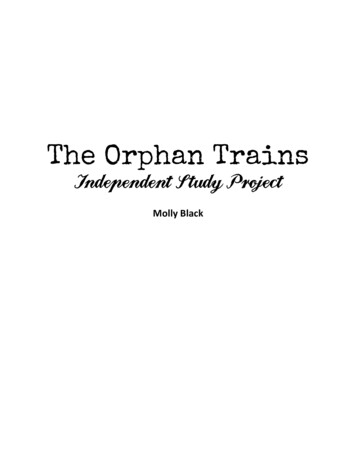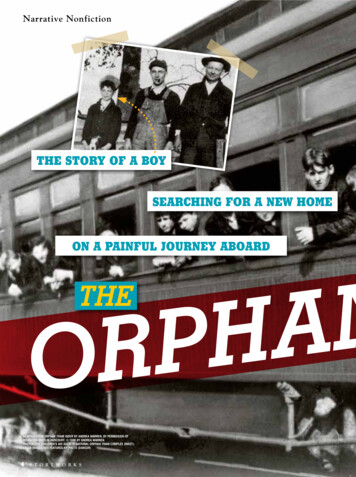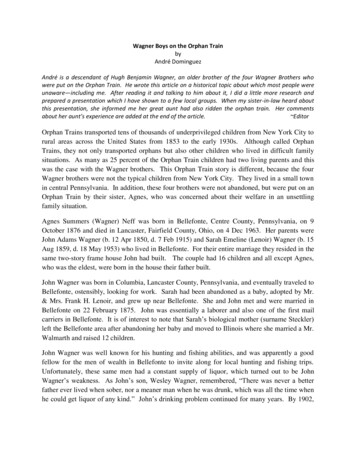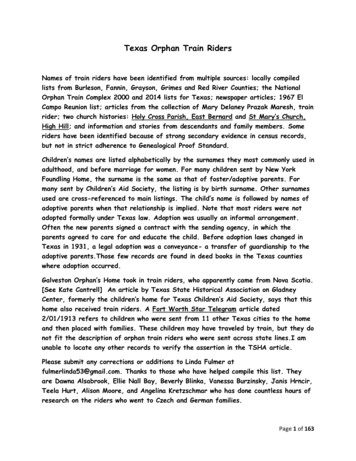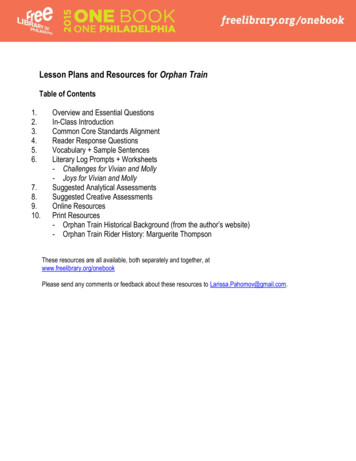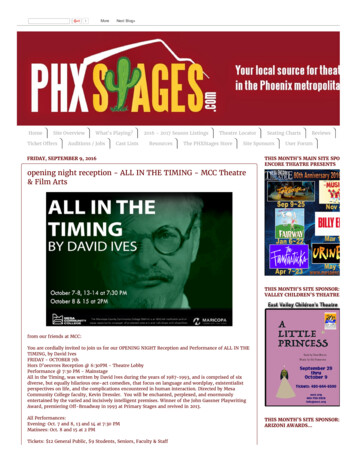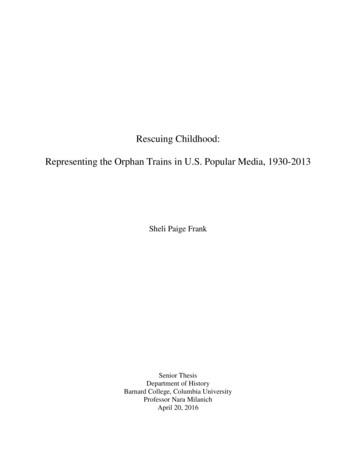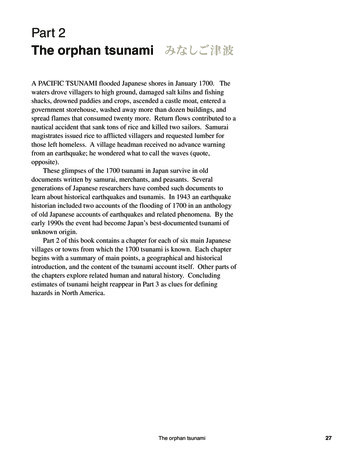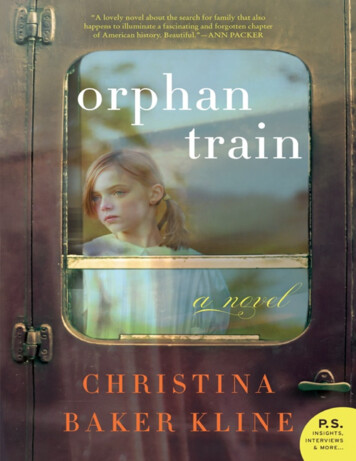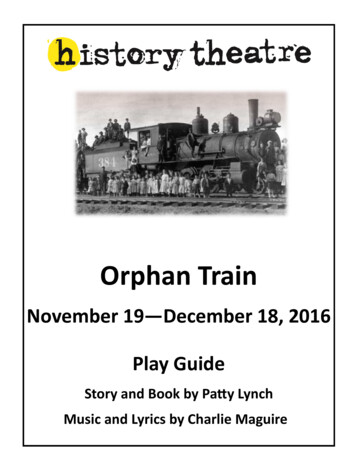
Transcription
Orphan TrainNovember 19—December 18, 2016Play GuideStory and Book by Patty LynchMusic and Lyrics by Charlie Maguire
30 East Tenth StreetSaint Paul, MN 55101651-292-4323 Box Office651-292-4320 Group Saleshistorytheatre.comTable Of ContentsPages 3—7A History of the Orphan TrainsPage 8Orphan Train Riders of MinnesotaPage 9-11Railway SystemsPage 12TimelinePage 13American Folk MusicPage 15-20ActivitiesPage 21-22Furthering Reading
A History of the Orphan TrainsIn 1853, the United States began surveyingrailroad lines to the Pacific, mapping four differentroutes. Posters, flyers and advertisements weresent to Europe and the rest of the world extollingthe virtues of coming to America and gettingfree land. Many were led to believe America wasthe land of milk and honey they so desperatelywanted for themselves and their children. As aresult, the United States received a larger numberof immigrants than any other country inhistory. Between 1841 and 1860, America welcomed 4,311,465 newcomers. Many left their homelandsbecause of poor harvests, famines, political unrest and revolutions. Agents of steamship lines along with therailroad companies attracted thousands to the United States with words such as “the land of opportunity”and “land of a second chance.” This brought laborers for the factories, tenants for western lands, and oftenchaos to young families when housing became a problem. In 1820, the U.S. population was about 9.6million. Within four decades, 5 million European immigrants would arrive, nearly all from Ireland, Englandand Germany. By 1900, 16 million Irish had come to America, and the population was 76.1 million.The first U.S. orphanage reportedly was established in 1729 after Indians massacred settlers near Natchez,Miss. But institutional solutions were uncommon before the early 19th century, and relatives or neighborsusually raised children who had lost parents. Arrangements were informal and rarely involved courts.About 1830, however, the problem of homelesschildren mushroomed in large Eastern cities that wereports of entry for immigrants, particularly New York. In1850, when New York City’s population was 500,000, anestimated 10,000 to 30,000 homeless children lived inthe streets or were warehoused in more than twodozen orphanages. During those years orphanageswere few in number and often grossly overcrowded.Children typically received minimal food, education andattention. Many were sons and daughters of down ontheir luck immigrants.Some children were orphaned when their parents died in epidemics of typhoid, yellow fever or the flu.Others were abandoned or orphaned by parents victimized by grinding poverty of the slums, relentlessdiseases or drug and alcohol addiction.3
In 1865, 10 Boston businessmen formed the New England Home for Little Wanderers to care for the childrenorphaned by the Civil War. The agency began sending children out west, not as indentured servants but foradoption. The first orphan train left Boston in 1850 and carried 30 homeless waifs to New Hampshire andVermont. They were wards of the Children’s Mission to the Children of the Destitute, a Protestant charitythat was the first to send agents to search the streets, docks, theaters and railway stations for children inneed of supervision. Many were the children of impoverished Irish Catholic immigrants or immigrantsthemselves. Later, they included children whose fathers were killed in the Civil War.There were two main institutions responsible for this mass emigration of children from New York. Thoseinstitutions were The Children’s Aid Society, and The New York Foundling Hospital. While this placementeffort of orphans was not entirely original to these two institutions, they are the institutions that most oftencome to mind when discussing the Orphan Train movement. The first train went out from The Children’sAid Society on September 20, 1854, with 46 ten-to-twelve year old boys and girls. Their destination wasDowagiac, Michigan. All 46 children were successfully placed in new homes.Rev. Charles Loring Brace and The Children’s Aid SocietyBrace, a 26-year-old Congregational minister, found his calling a littlecloser to street level than the that of the pulpit. He started to haveconcerns in 1853 about the growing number of homeless children he sawwandering the streets of New York. He joined together with otherreformers and founded the Children’s Aid Society. Brace’s early outreachconsisted of boys meetings at which time they received food and Bibleinstruction. Unlike other charitable institutions of the time, he wanted toprovide them with more than just food, clothing, and a place to sleep. Hefelt that education and the opportunity to learn a trade were necessaryingredient in properly caring for these children. For a short while, he triedhelping these children with his institutions in New York City; establishingschools for them, teaching the boys a trade, inviting volunteering ladies tohelp teach the girls the proper way to behave and dress, establishing asavings bank to teach the boys to save their money rather than gamble it away. But just a year afterfounding the Children’s Aid Society he quickly realized that something more needed to be done. He decidedthe solution was work.However, New York labor refused to employ boys. He hitched the idea of foster care and jobs with theexpanding railroad system. Thus, he took up the plan that Boston had tried ten years earlier which involvedtaking orphans from the street, sending them west on trains and placing them out to families at the variousstops along the way who were willing to adopt them.4
The Boston plan had also allowed for children to be taken on as indentured servants, but this was not anacceptable option to Brace. He developed what he called the family plan. This meant that the child shouldbe taken into a home and treated as part of the family. He expected the adoptive families to provide for theorphans with the same food, clothing, education, and spiritual training that they would for their ownbiological children. Sometimes this happened, sometimes it didn’t. Overall, Brace felt these orphans had abetter chance at life with placement in a new home out west than they did remaining on the streets of NewYork. He also felt moving these children west was better for them health-wise than remaining in the city.The first group was sent out on September 20, 1853 —and America’s first foster children were placed.Most children on the trains were white. The largest number of trains went to the Midwest, much of whichhad been settled by immigrants from Western Europe. Societyofficials knew that children with the best chance of a new homewere those with backgrounds similar to those of prospective fosterfamilies. Language could also be a consideration. An attempt wasmade to place non-English speakers with people who spoke theirlanguage. Babies were easiest to place, but finding homes forchildren older than 14 was always difficult because of concern thatthey were too set in their ways or might have bad habits.The basic procedure for adopting children from The Children’s Aidwas to determine which children were to be sent out. If a childwas not a true orphan release for placement was obtained fromwhatever parent/guardian remained available. It was then decidedwhere the train would travel, and what towns it would stop at.Advance notice of Homes Wanted for Orphans would be placed in key newspapers by the placing agentswho were to accompany the children. It was desirable to have one male and one female agent accompanyeach group, but this was not always the case. Shortly before the day of departure (oftentimes just the nightbefore) the children would be told that they were going on thetrain. They would be bathed, given new clean clothing, and theirhair tended to. Then they would board the train and would be offto their new destiny.When the trains pulled into the stations, the caretakers would getthe children cleaned up and ready for inspection. The childrenwould typically arrive in a town where local community leadershad assembled interested townspeople. The children wouldusually be put up on a stage like podium for viewing and inspection. This became known as being “Put UpFor Adoption”. Children might sing or dance to attract interest. The townspeople would inspect thechildren, perhaps feeling muscles and checking teeth, and after a brief interview take the chosen oneshome. Some children became indentured servants to their host families, while most were adopted, formallyor informally, as family members.5
One of the saddest parts of this procedure was often the new parents could not take more than one child. Ifbrothers and sisters were lucky, they were taken by families in the same area so they could visit. If theywere not lucky, brother, or sister, would get back on the train without them and go many miles furtherdown the track. It was not uncommon for brothers and sisters to lose contact with each other completely .Most children lost any means of contacting their relatives. They were never to speak, or think of theirfamilies again. The children were encouraged to break completely with their past and completely start overwith new families. The older children would remember their old life while the babies would have nomemory of life in New York.Although the demand was motivated by a need for labor, the Children’s Aid Society took pains to ensure thechildren were well cared for. Families applying to take children had to be endorsed by a committee of localbusiness owners, doctors, and journalists. According to the society's “Terms on Which Boys are Placed inHomes,” boys under twelve were to be treated by the applicants as one of their own children in matters ofschooling, clothing, and training, and boys twelve to fifteen were to be sent to a school a part of each year.Representatives from the society would visit each family once a year to check conditions, and children wereexpected to write letters back to the society twice a year.Sister Irene and the New York Foundling HospitalThe story of Sister Irene and the New York Foundling Hospital runsparallel with that of Rev. Brace and the Children’s Aid Society. However,there were a few key differences in how they placed children in newhomes.The Sisters of Charity of Saint Vincent de Paul created the CatholicCharities of New York in 1869. Through The New York Foundling Hospital,they had always taken in abandoned babies. In the foyer of their buildingstood a white cradle were mothers could anonymously leave theirchildren to be cared for by the Sisters. But as knowledge of the cradlespread, it wasn’t long before there were more children than they couldadequately care for. Thus, began the Foundling Hospital’s mercy trainsalso known as baby trains. The Sisters worked in conjunction with Priests throughout the Midwest andSouth in an effort to place these children in Catholic families. While the Children’s Aid Society requestedthat the children they place be given spiritual training (the choice of religion was left up to the adoptive family), the Foundling Hospitals placements were strictly to Catholic families.Probably the largest difference in how the Foundling Hospital placed their children is that the children werenot sent out to be randomly adopted from a town hall or opera house, but were requested ahead of time byfamilies who wanted a child. Requests would be sent to the NYFH for a child and then the Sisters would do6
their best to find a matching child. They would then send the requesting family a receipt for the child tellingwhen and where the child would arrive by train. This notice requested that the family be at the stationahead of time so as not to miss the train. When the train arrived, the new parents were to have their noticeof arrival with them which they were to present to the Sisters. The notice had a number on it that wouldmatch up with a child on the train. Once the match was made, the parents signed the receipt for the childand they were free to leave with their new child.The orphan trains had detractors. In New York, Brace was called a child stealer and criticized for shippingthem wholesale into the country. Some of the states where children were sent complained they wereplaced indiscriminately in poorly supervised foster families. Abolitionists described the displays of childrenas ‘slave auctions.’ In Boston, they were criticized for turning immigrant Catholic children to Protestants,since children were sent away to mostly Protestant families.The number of Orphan Trains began to decline dramatically in the 1920’s. Many factors contributed to thedecline and eventual end of the placing out programs. Perhaps the most significant road block for theorphan trains was the growing number of state legislatures that began passing laws to restrict or forbid theinterstate placement of children. New laws limited hours children could work, and others made it difficult orimpossible for trainloads of orphans to move from one state to another.In 1887, Michigan passed the first law in the United States regulating the placement of children within thestate. Again in 1895, Michigan passed a state law requiring out-of-state, child-placement agencies to post abond for each child the agency brought into the state. In 1899, Indiana, Illinois and Minnesota enacted similar but stricter laws which had the effect of prohibiting the placement of incorrigible, diseased, insane orcriminal children within their state boundaries. Using these state laws as models, Iowa, Kansas, Kentucky,Missouri, North Dakota, Ohio, and South Dakota passed similar laws within five years.Over the 75-year span of the Orphan Trainmovement, it is estimated that between150,000 and 200,000 orphan children wererelocated to new homes via the OrphanTrains. The Orphan Train Movement led to ahost of child welfare reforms, including childlabor laws, adoption and the establishment offoster care services, public education, theprovision of health care and nutrition andvocational training. The orphan trainmovement and orphan train placements were not the driving force for modern laws. Instead, many ofthese reforms came about to specifically oppose orphan train practices.7
Orphan Train Riders in MinnesotaThe Orphan Train Riders of New York-Midwest is the oldest orphan train rider group in the nation. Theorganization has been meeting annually since thefirst gathering in Wahpeton, North Dakota in 1961.Beginning that year, a group of nine people who hadarrived in the Midwest via the orphan trains met anddecided to assemble yearly to share their experiencesand memories. The next year, thirty-five riders fromacross the country met. The organization grew overthe years, with attendees eventually including familymembers of the riders and those with an interest inand a desire to keep the stories alive. The 56thmeeting took place in Little Falls, Minnesota inSeptember. Most of those attending in recent yearsare children and grandchildren of the original riders,seeking to find out and reminisce about familyexperiences.The orphan trains ran for 75 years, from 1854 to 1929. During that time, it is estimated that 5000 to 6000children were sent to Minnesota, nearly half of whom arrived between 1882 and 1892. The Midwest wasseen as a quiet and honest place in contrast to densely populated cities where the children originated from,a place in which to learn how to work hard and learn family values.By the time the Orphan Trains officially stopped running, many states had passed legislation regulating thecare of dependent children. Orphanages, state schools, and private organizationsbegan to take on more and more responsibility. Children’s Home Society ofMinnesota got its start in 1889 when Reverend E.P. Savage established Children’sAid Society of Minnesota in St. Paul, intent on finding homes for deserted andneglected children during the time when many were arriving to the Midwest.In 2010, Governor Tim Pawlenty declared June 19 Orphan Train RidersRecognition Day.Earlier this year on May 22, Sophia Kaminsky Hillesheim-Kral passed away at theage of 101. She was the last surviving orphan train rider in Minnesota.For more information and personal stories, go to the Orphan Train Riders of Minnesota m8
Railway SystemsNew York to Chicago and Chicago to MinnesotaBefore the first railroad existed the main transportation on the East Coast was water steam boats. In thewest it was by wagon, horse, or on foot. The railroads of the United States have a rich and sordid past oftake overs, bankruptcy, and greed. They played a large role in the development of the United States fromthe industrial revolution to the settlement of the West. The American railroad mania began with theBaltimore and Ohio Railroad in 1828 (initially using horses to pull train cars) and flourished until the Panic of1873 which bankrupted many companies and temporarily ended growth.Railways in the New York area in the 1840’s were broken up into ten different railroad companies, oftenonly running less than 100 miles. Eratus Corning, President of the Mohawk Valley Railroad, organized ameeting of executives and stockholders in March of 1853 and convinced them to merge to create a moreefficient regional system.The Vanderbilt EraCornelius Vanderbilt Jr. was born on May 27, 1794 in Richmond County (now knownas Staten Island) to Phebe Hand Vanderbilt and Cornelius Vanderbilt Sr. Whileowning a farm Cornelius Sr bought a periauger, which is a two mast boat, andbegan trading with his neighbors in New York. In his youth, Cornelius purchased hisown periauger and used it as a passenger boat to bring people to and from StatenIsland. During the War of 1812, he contracted with the US Government to shipsupplies to outposts. Such was his energy and eagerness in his trade that othercaptains nearby took to calling him The Commodore in jest - a nickname that stuckwith him all his life.At age 70, Vanderbilt turned his attention more closely to railroads, acquiring the New York & Harlem andHudson Line. In 1867 he brought the New York Central Line to its knees and then purchased the railroad. In1869 he acquired the Lake Shore and Michigan Lines. He eventually consolidated his hold on rail traffic fromNew York to Chicago. This new conglomerate revolutionized rail operations by standardizing proceduresand timetables, increasing efficiency and decreasing travel and shipment times.Minnesota and the Railroad:The completion of a railroad in Minnesota was not an easy feat, as the costs of a railway were extremelyexpensive to a newer state. Finding funding was a huge undertaking after the 1857 market crash that madeinvestors very nervous to invest in land development. Funding from the Minnesota Legislation was pulledmore than once and then brought back. During the Civil War, with men being away and money goingtowards the war, the railway was at a standstill until the war was over and legislation was signed and9
funders from the east coast were procured. The names of these men that worked to build the railroad inMinnesota may only be remembered now due to the streets that are named after them; David ChaunceyShepard and Edmund Rice.May 20, 1862 President Lincoln signed the Homestead Act that encouraged people to move out west toWisconsin, Minnesota, Iowa, and the Dakotas. If they made the move, they would be given land to farm andlive off to make a living. In July of 1864 Lincoln signed a charter of the Northern Pacific Railway the secondtranscontinental railroad. During the 1870s’ to the 1890s’ the population in the Midwest grew from 200,000to nearly 3,000,000. In those 20 years St Paul shifted from the gateway city of oxcarts and steam boats torailroads.The most famous Minnesotan railroad magnate was J.J. Hill. In 1857 theline between St Paul and St Anthony began, but was short lived due tothe market crash, but in 1859 it was started again. However, there weremany who believed that the mainline from Stillwater for St Anthony wasno longer the focus and the line from St Paul was the only thing beingworked on. After years of struggling to build the line it was finallycompleted for commercial rides in June of 1862.By 1889, Hill decided that his future lay in expanding into atranscontinental railroad. The Great Northern was the firsttranscontinental built without public money and just a few land grants.It was one of the few transcontinental railroads not to go bankrupt. TheGreat Northern energetically promoted settlement along its lines inNorth Dakota and Montana. This "Dakota Boom" peaked in 1882 as 42,000 immigrants, largely fromnorthern Europe, who poured into the Red River Valley running through the region.10
New York to Chicago. The different colors stand for the different railroads, they are described below.1) Hudson River Rail Road (Pink) to New York Central (Purple) went through New York and then splits to theGreat Western (Light Blue) to Detroit then became the Michigan Central Rail Road (Red) to Chicago or LakeShore and Michigan Southern Line (Orange).2) New York Central (Purple) to Canada Southern Rail Rode (Green) to Detroit, Michigan Central (Red) or theLake Shore and Michigan Line (Orange).3) New York Central (Purple) to Lake Shore and Michigan Southern line (Orange).4) Erie Rail Road (Teal) to Lake Shore and Michigan Southern line (Orange).The Train Ride from Chicago to St Paul1) Milwaukee and Minnesota Rail Road (Green)2) Chicago and North West Rail Road (Red)3) Chicago, Iowa, and Northern Rail Road (Purple)11
Time-Line1850 The first Orphan Train leaves Boston from the Children’s Mission tothe Children of the Destitute1851 Massachusetts passes the first modern adoption law, recognizingadoption as a social and legal operation based on child welfare ratherthan adult interests.1853 Rev. Charles Loring Brace founded the Children’s Aid Society of NewYork.1854 The Children’s Aid Society of New York launches the orphan trains.1858 Minnesota admitted to the Union1860 Abraham Lincoln elected president1862 President Lincoln signs the Homestead Act to encourage people tomove out West.1868 14th Amendment grants citizenship to African-Americans1868 Massachusetts Board of State Charities begins paying for children to board in private homes. This wasthe beginning of indentured or “placed-out” a movement to care for children in families rather thaninstitutions.1869 Sister Mary Irene Fitz Gibbon and two other Sister of Charity welcome their first abandoned infant1872 New York State Charities Aid Association is organized. It is one of the first organizations in the countryto establish a specialized child-placement program, in 1898.1869 Transcontinental Railroad completed1873 Massive bank failures plunge nation into severe depression1878 The Great Dakota Boom begins (over 1,000,000 acres settled)1901 Kansas passed legislation mandating that the State Board of Charities had authority to scrutinize allorganizations or institutions placing children. With the passing of that legislation, the boardimmediately ruled that no homeless children could be brought into Kansas without a certificate ofgood character and a five-thousand-dollar security bond.1909 First White House Conference on the Care of Dependent Children declares that poverty alone shouldnot be grounds for removing children from families.1912 Congress creates the U.S. Children’s Bureau in the Department of Labor “to investigate and report onall matters pertaining to the welfare of children and child life among all classes of our people”.1912-1921 Baby farming, commercial maternity homes, and adoption ad investigations take place in Boston,New York, Baltimore, Chicago and other cities.12
American Folk Music in the late 19th & Early 20th CenturyAmerican folk music is an all-encompassing term that describes various musical genres either created ordeveloped in the United States, including traditional folk music and roots music. Roots music falls under theumbrella of the term folk music. It is used to refer to a broad range of musical genres, which includes blues,gospel, traditional country, zydeco, Tejano, and Native American Pow-Wow. At the beginning of the 20thCentury, the term "folk music" was used by scholars to describe music made by whites of Europeanancestry, often in the relatively isolated rural South. As the century progressed, the definition of folk musicexpanded to include the song styles, particularly the blues, of Southern blacks as well. In general, folk musicwas viewed as a window into the cultural life of these groups. Folk songs communicated the hopes, sorrowsand convictions of ordinary people and their everyday lives. Increasingly, music made by other groups ofAmericans such as Native Americans, Mexican-Americans, and Cajuns came under the umbrella of "folkmusic." It was sung in churches, on front porches, in the fields and other workplaces, and at parties. Themelodies and words were passed down from parent to child, though songs, and their meanings, oftenevolved to reflect changing times.Academically and within the tradition of American folk music, a folk song is one that uses traditionalmelodies to speak on a particular topic. Often, topical folk songs address social and political issues such aswork, war, and popular opinion, although not all folk songs are topical or political. Some are personal dirgesor ballads about family stories, love songs, or even nonsense songs. A folk song can be passed down withina family or community, and can evolve to reflect issues of the day. Like many traditions in early American,folk music has roots in a variety of different sources. Early settlers would bring over their own musical styles,which included popular ballads such as Barbara Allen from England and Scotland. African-American folkmusic can trace its origins to slavery and emancipation. Early spirituals described the hardships of slaveryalong with Christian elements and values.Soon, folk music developed and evolved in America, forming genres and traditions unique to the Americanexperience. Songs that survive to this day, such as Yankee Doodle, reflected the “New World” and thedistinct nature of having multiple cultures contribute to a new style of music. Eventually regional formsdeveloped, such as Appalachian in the eastern United States. It is derived from European and Africaninfluences, including English, Irish and Scottish ballads and hymns. The music is typically characterized by theuse of banjo, fiddle, and guitar. Another distinct regional form is the blues, originating in the Deep South byAfrican-Americans. Blues incorporated spirituals, work songs, and field songs to create rhythms and groovesto relate the troubles experienced in African-American societies.In the late 19th century and early 20th century, the accessibility of records led to folk music spreading outfrom its various regional areas to reach listeners all across the country. “Hillbilly" and "race" records becameprofitable recording industry genres that popularized regional music. The emergence of radio broadenedaudiences and helped the cross-fertilization of various musical forms. A movement was also begun withscholars and music industry entrepreneurs traveling throughout the nation to record authentic folk musicfrom musicians both amateur and professional.In the 1960s, awareness of folk songs and musicians grew, and popular musicians began to draw on folk music as an artistic source as never before. "Folk music" then became a form of popular music itself, popularized by singer/songwriters such as Bob Dylan, who helped pioneer the intimate, often acoustic performingstyle that echoed that of community-based folk musicians. Music writers, scholars and fans began to lookfor new ways to describe the diverse array of musical styles still being sung and played in communitiesacross America, though most often not heard on radios.13
ACTIVITIES
Discussion and Writing Activities1.Discuss whether or not the Children's Aid Society child placement program would be appropriate today.What must people consider when designing a foster care program? Brainstorm a list of goals for suchprograms.2. Ask students if the first-hand accounts in the play affected how they viewed the whole story. Who didn'tthey hear from directly? If they had heard from these other people, how do they think it might have affectedtheir view(s)?3. Have students research the history of foster care in the United States. Ask them to consider how changesin this system have reflected changes in society's view of children. After students finish their research, havethem work in small groups to outline a successful foster care program, then present their ideas to the class.4. Ask students to imagine life as a homeless child in the 1800s living on New York City's streets, taking anorphan train, then living with a family in rural America. Have them write a story or poem about theexperience.5. Introduce students to the topic of orphan trains by showing them the videos of individual orphans fromthe trains on YouTube. Working in groups of two or three, have students brainstorm words describing thesituation of the orphan train riders and record them. Encourage students to come up with as manydescriptive words as possible. When they have finished, have students use their descriptive words to createa word cloud with Wordle orTagxedo.
HomeAsk students to develop a concept of home based upon their own personal experiences and preferences.Have them consider such basic factors as food, shelter, safety, and comfort and then move on to areas suchas security, stability, family and community, etc.Have students work in groups to establish 10-point descriptions of HOME by incorporating 10 sentences thatbegin with, Home Is TrainsAsk students to research travel by train in 19th Century America. Having them work in pairs, ask them tocreate a travel itine
Orphan Train November 19—December 18, 2016 Play Guide Story and ook by Patty Lynch Music and Lyrics by harlie Maguire . 30 East Tenth Street Saint Paul, MN 55101 651-292-4323 ox Office 651-292-4320 Group Sales historytheatre.com Table Of
